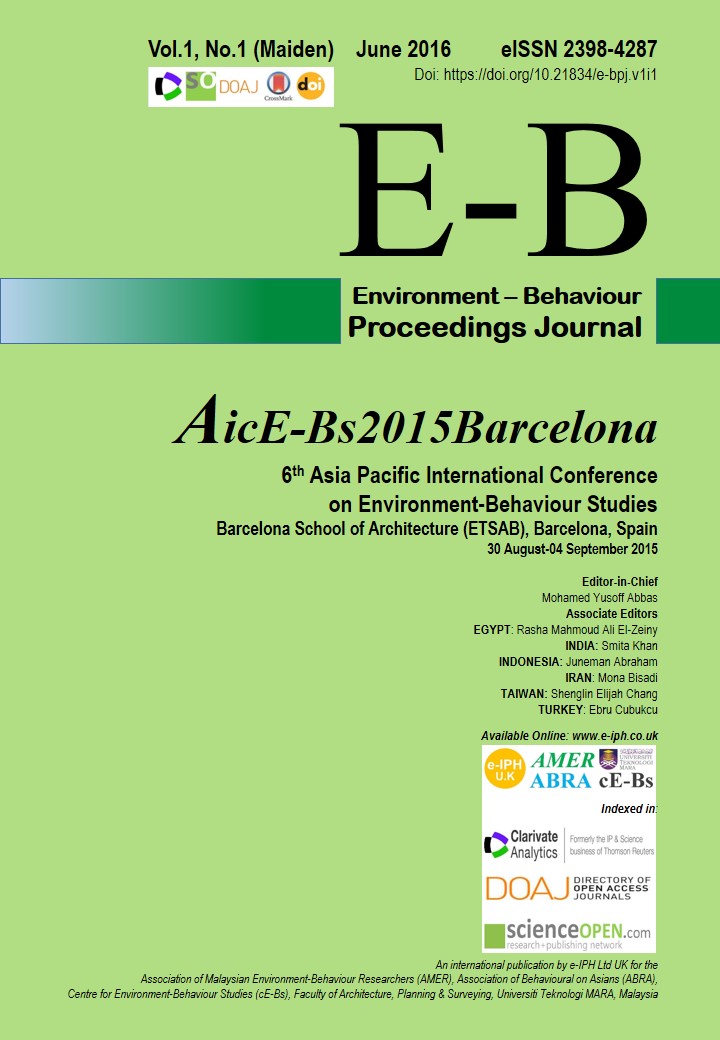Investigating User Perception of High-Performance Schools about Factors Associated with Building Energy Efficiency
DOI:
https://doi.org/10.21834/e-bpj.v1i1.203Keywords:
User Perception, Building Energy Index, Building Energy Efficiency, School BuildingAbstract
Energy demand in buildings can be reduced by improving energy efficiency. MS1525 has recommended that energy efficiency for Non- Residential Buildings in Malaysia to be not more than 135kWh/m²/year. A school building is a non-residential building and has major social responsibilities. Based on the theory of building energy-efficiency, energy efficiency can be achieved through three main factors: a) design of buildings; b) design of services; and c) user behavior. This study aims to investigate the user perceptions in High-Performance Schools. The questionnaire viewed three main perceptions of users: perception of user behavior, the perception of building design and perception of services design.
References
Al-Mofleh, A., Taib, S., Mujeebu, M. A., & Salah, W. (2009). Analysis of sectoral energy conservation in Malaysia. Energy, 34(6), 733–739. DOI: https://doi.org/10.1016/j.energy.2008.10.005
Al-Rubaih, M. S. (2008). Energy-Efficient Envelope Design For Schools in Saudi Arabia. King Fahd University of Petroleum & Minerals.
Bin, S. (2012). Greening Work Styles: Analysis of Energy Behavior Programs in the Workplace. Techniques (Vol. 20045).
BP. (2015). Energy charting tool. Retrieved from http://www.bp.com/en/global/corporate/about-bp/energy-economics/energy-charting-tool.html
Building Consumption Input, & System. (2013). Method to Identify Building Energy Index (BEI), NET BEI, GFA, NFA, ACA. Malaysia.
Cohen, J. (1988). Statistical power analysis for the behavioral sciences. Hillsdale: NJ: Erlbaum.
Filippín, C. (2000). Benchmarking the energy efficiency and greenhouse gasses emissions of school buildings in central Argentina. Building and Environment, 35, 407–414. DOI: https://doi.org/10.1016/S0360-1323(99)00035-9
Government of Malaysia. (2010). Tenth Malaysia Plan. Percetakan Nasional Malaysia Berhad, Headquarters, Kuala Lumpur., 253–327.
Hassan, J. S., Zin, R. M., Majid, M. Z. A., Balubaid, S., & Hainin, M. R. (2014). Building Energy Consumption in Malaysia: An Overview, 7, 33–38. DOI: https://doi.org/10.11113/jt.v70.3574
Hoes, P., Hensen, J. L. M., Loomans, M. G. L. C., De Vries, B., & Bourgeois, D. (2009). User behavior in whole building simulation. Energy and Buildings, 41, 295–302. DOI: https://doi.org/10.1016/j.enbuild.2008.09.008
King J, & RW, M. (1979). The physical environment and the learning process: A survey of recent research. Architectural Research Laboratory.
Lackney, J. A. (1999). Assessing School Facilities for Learning/Assessing the Impact of the Physical Environment on the Educational Process: Integrating Theoretical Issues with Practical Concerns, 36.
Lutzenhiser, L. (1993). Social and Behavioral Aspects Of Energy Use. Annu. Rev. Energy Environ., 18(2), 47–89. DOI: https://doi.org/10.1146/annurev.eg.18.110193.000513
Masoso, O. T., & Grobler, L. J. (2010). The dark side of occupants’ behavior on building energy use. Energy and Buildings, 42, 173–177. DOI: https://doi.org/10.1016/j.enbuild.2009.08.009
Nunnally, J.C. & Bernstein, I. . (1994). Psychometric Theory. New York: McGraw-Hill.
Pallant, J. (2005). SPSS Survival Manual; A Step by Step Guide to Data Analysis Using SPSS for Windows. Sydney, Australia: Allen & Unwin.
Salleh, M. N. M. (2008). Reka Bentuk Sekolah Kebangsaan Daripada Aspek Kecekapan Tenaga: Kajian Kes Di Daerah Perak Tengah [LB3221. N162 2008 f rb]. Universiti Sains Malaysia. Retrieved from http://eprints.usm.my/9095/
Salleh, M. N. M., Kandar, M. Z., & Md Sakip, S. R. (2015). Users ’ Perception of Energy Efficiency in School Design. Procedia - Social and Behavioral Sciences, 170, 155–164. DOI: https://doi.org/10.1016/j.sbspro.2015.01.025
Schipper, L., & Saidur, R. (2009). Energy consumption, energy savings, and emission analysis in Malaysian office buildings. Energy Policy, 37(10), 4104–4113. DOI: https://doi.org/10.1016/j.enpol.2009.04.052
United Nations Environment Program. (2015). Why Buildings ? Retrieved April 15, 2015, from http://www.unep.org/sbci/AboutSBCI/Background.asp
Wheeler, A., Boughlagem, D., & Malekzadeh, M. (2011). Developing a child-friendly post-occupancy assessment methodology for sustainable schools. Third International Conference on Applied Energy, 1–19.
Widman, R. O. N., Kaplan, R., & Young, R. D. E. (1984). Behavioral Approaches to Energy Conservation in Organizations: A Selected Review of the Literature. East, (November).
Downloads
Published
How to Cite
Issue
Section
License
Copyright (c) 2016 Mohd Najib Mohd Salleh, Mohd Zin Kandar, Siti Rasidah Md Sakip

This work is licensed under a Creative Commons Attribution-NonCommercial-NoDerivatives 4.0 International License.





